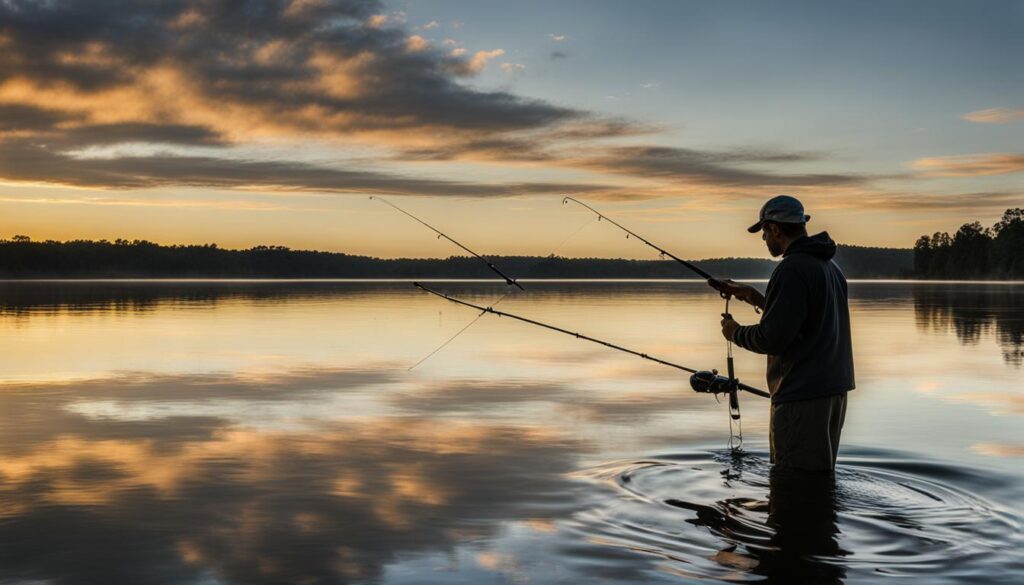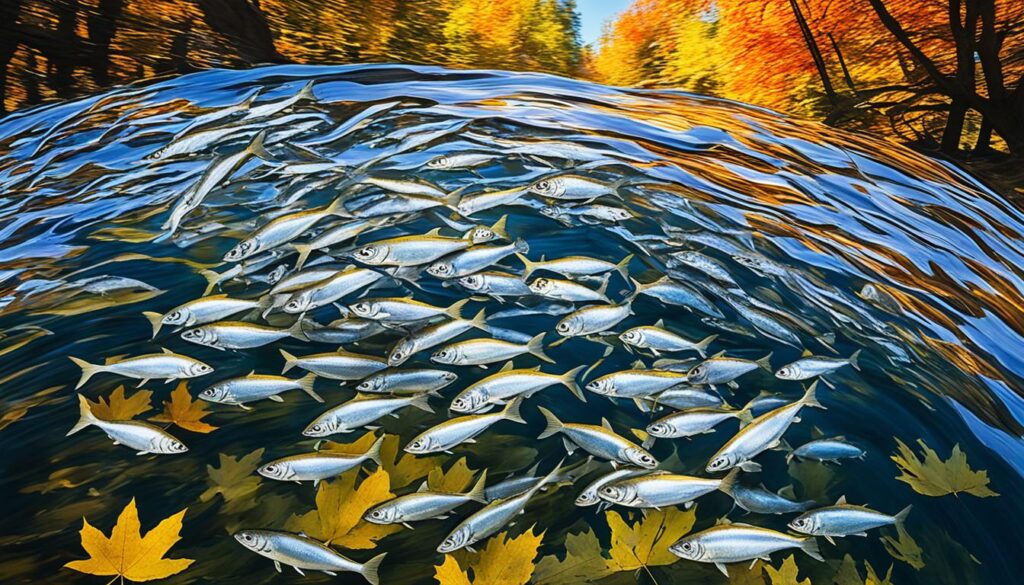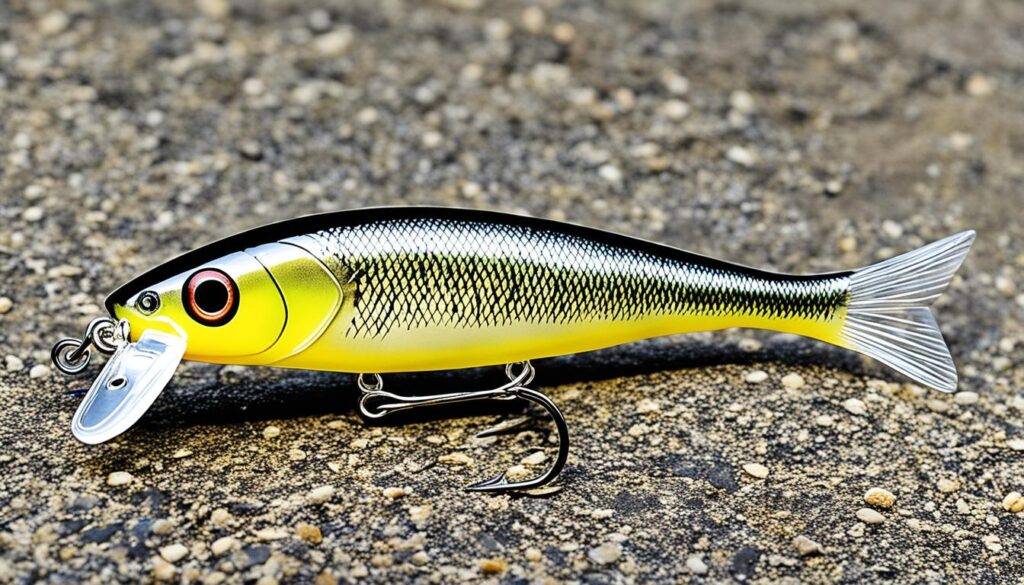Fall bass fishing is a popular activity during the autumn months. Soft jerkbaits, or Flukes, are a versatile and effective lure for catching bass this season. They imitate baitfish and can be used by anglers of all skill levels. This article will explore two proven patterns for fall bass fishing with soft jerkbaits.
Angler’s Essentials:
- Soft jerkbaits are versatile and effective lures for fall bass fishing.
- Pattern 1: “Dead Sticking” Grass Lines—Target finicky bass near the edge of grass lines with a salted–core soft jerkbait.
- Pattern 2: Schooling Fish – Use Fluke-style bait to imitate baitfish and trigger strikes from bass in the water column.
- Soft jerkbaits can be rigged in various ways for different fishing conditions.
- Targeting bass near heavy cover can be done effectively with soft jerkbaits.
Pattern 1: “Dead Sticking” Grass Lines
“Dead sticking,” a soft jerk bait near the edge of grass lines, effectively targets finicky bass in the fall. Anglers like Matt Arey have succeeded with this pattern, especially in heavily pressured lakes. Arey recommends using a soft jerk bait with a salted core, such as the Lunkerhunt Descend Minnow, with a shortfall and enticing bites. By allowing the bait to settle and shimmy near the grass, anglers can trigger strikes from bass that are keying in on baitfish hiding in the vegetation.
Fall grassline fishing can be a productive strategy for bass anglers seeking to catch elusive fish. The technique involves casting a soft jerkbait, like the Lunkerhunt Descend Minnow, along the edges of submerged grass beds. The slow, tantalizing fall of the bait mimics a wounded baitfish, attracting the attention of hungry bass lurking in the area. By dead-sticking the soft jerkbait and allowing it to rest motionlessly near the grass, anglers can entice strikes from bass that are hesitant to chase fast-moving lures. This patient approach is efficient in heavily pressured lakes where bass have become wary of aggressive presentations.
The Lunkerhunt Descend Minnow is an excellent choice for fall grassline fishing. Its salted core gives the bait a tantalizing action that drives the bass wild. The slow sinking nature of the Descend Minnow allows it to hover in the strike zone near the grass, imitating an injured or dying baitfish, which is an irresistible meal for hungry bass. Anglers can experiment with different retrieves, including short twitches followed by pauses, to imitate the erratic movements of baitfish trying to escape predators. Fall grass line fishing with a dead-sticking soft jerk bait can often result in explosive strikes and memorable catches.
Pattern 2: Schooling Fish
Regarding fall bass fishing, soft jerkbaits are a go-to choice for catching schooling bass. These lures are particularly effective in actively enticing bass to feed on baitfish high in the water column. One popular type of soft jerkbait is the Fluke-style bait, such as the Zoom Super Fluke or Yamamoto D Shad. With their lifelike appearance and realistic swimming action, these baits can be irresistible to bass.
Soft jerkbaits offer a stealthy approach that can trigger bites when topwater lures fail to produce results. Anglers can rig the soft jerkbait weightless or with a different hook size, depending on their preferred presentation. Try twitching the bait with short, quick jerks for a slow and subtle retrieve. If you are searching for a more aggressive approach, try a series of rapid, hard jerks followed by a pause. These techniques provide versatility to match the feeding behavior of schooling bass.
Combining the one-two punch of topwater lures and soft jerkbaits can be highly effective for fall bass fishing. This technique allows anglers to cover different parts of the water column and entice strikes from various depths. This comprehensive approach increases the chances of hooking into actively feeding bass and maximizing the potential for a successful outing.
| Advantages of Soft Jerkbaits for Schooling Bass |
|---|
| Stealthy and natural presentation |
| Ideal for targeting bass feeding high in the water column |
| Versatile rigging options for different presentations |
| Can trigger bites when topwater lures are not effective |
| Potential to attract larger schooling bass |
Note: Schooling bass are often more aggressive and competitive, making them prime targets for anglers. By using soft jerkbaits and imitating baitfish behavior, anglers can effectively tap into this feeding frenzy and increase their chances of landing quality bass.
Pro Tip: The Stealthy Nature of Soft Jerkbaits
Soft jerkbaits’ ability to closely mimic the appearance and movement of injured or distressed baitfish makes them a top choice for targeting schooling bass. Their realistic swimming action and lifelike profile create a compelling presentation that can trigger aggressive strikes. When other lures fail to garner attention, the subtle and natural movements of a soft jerkbait often stand out to bass in a schooling frenzy.
Recommended Soft Jerkbaits for Schooling Bass

The Adaptability of Soft Jerkbaits
Soft jerk baits are incredibly versatile lures that can be rigged in various ways to suit different fishing conditions. Anglers can Texas rig them in heavy cover, nose hook them in clear water, or even “donkey rig” them for active bass. Different rigging methods can yield different results, so attention to detail is essential. Tim’s rigging methods, as discussed in a video, provide insights into maximizing the effectiveness of soft jerkbaits for fall bass fishing.
Texas Rigging Soft Jerkbaits
One popular method for rigging soft jerkbaits is the Texas rig. This involves inserting a wide gap hook into the head of the soft jerkbait, then sliding a bullet weight onto the line above the hook. The weight can be adjusted to achieve the desired sink rate and keep the bait in the strike zone. Texas rigging allows the soft jerk bait to be presented effectively in heavy covers, such as around submerged vegetation or brush piles. The weedless design of the Texas rig helps prevent snagging, increasing the bait’s fish-catching potential.
Donkey Rigging Soft Jerkbaits
The donkey rig is another rigging option that can be effective for soft jerkbaits. This technique involves placing two hooks in the bait—one near the head and another near the tail—to create a more realistic presentation. The double-hook setup gives the soft jerkbait increased action and can entice even the most finicky bass to strike. The donkey rig is particularly effective when targeting active bass feeding aggressively in open water or near schooling baitfish. Anglers can experiment with different hook sizes and placements to find the donkey rig setup that works best for their fishing situation.
Soft jerkbaits’ adaptability makes them a valuable asset for anglers targeting bass in various conditions. Whether Texas rigging them in heavy cover or Donkey rigging them for active fish, soft jerkbaits have the potential to deliver results. By understanding the different rigging options and experimenting with presentations, anglers can optimize their use of soft jerkbaits to catch more bass during the fall season.
Targeting Bass Near Heavy Cover
When it comes to fall bass fishing, one strategy that anglers often overlook is targeting bass near heavy cover. This is where soft jerkbaits excel, providing an excellent baitfish imitation that bass find hard to resist. With their realistic appearance and enticing action, soft jerkbaits can effectively replicate injured or dying shad, making them a go-to lure for fall bass fishing.
The Strike King Caffeine Shad, a popular choice among anglers, is a weighted Texas-rigged soft jerkbait that excels at imitating baitfish. Its lifelike appearance and its rarity among anglers can make it a highly productive technique for fall bass fishing. Soft jerkbaits’ ability to dance in and out of heavy cover triggers a feeding response from wary bass, enticing them to strike.
By fishing soft jerk baits around heavy covers, such as submerged vegetation, laydowns, or brush piles, anglers can effectively target bass seeking refuge in these areas. The natural buoyancy and erratic action of soft jerkbaits allow them to navigate through tight spaces, mimicking the movements of injured baitfish. A soft jerk bait is likelier to entice bass lurking in heavy cover than other lures.
To maximize your success when targeting bass near heavy cover, consider the following tips:
- You can use a weighted Texas rig to ensure your soft jerkbait sinks quickly and reaches the desired depth near the cover.
- Experiment with different retrieval speeds and pauses to imitate the erratic movements of injured baitfish.
- In target transition areas, where the cover meets open water, the bass often position themselves to ambush prey.
- Pay attention to subtle cues like line movement or a slight tick, as bass may engulf the soft jerkbait without a noticeable strike.
Remember, confidence is key when fishing soft jerkbaits around heavy cover. Trust in the baitfish imitation capabilities of soft jerkbaits and persistently work the areas where bass are likely to hide. With the proper presentation and patience, you’ll be well on your way to hooking into big fall bass.
Importance of the Shad Migration
Shad migration plays a vital role in fall bass fishing. As cooler temperatures set in, bass actively feed on the migrating shad, making their way to the backs of creeks. While traditional fall fishing techniques like crankbaits and topwater lures are widely used, incorporating bottom-contact presentations can provide a unique advantage when other tactics fail to produce the desired results.

“Weighted Texas-rigged soft jerkbaits are my go-to when bass are feeding on shad during the fall migration. The bottom-contact presentation allows me to imitate the natural movement of injured shad, enticing bass to strike.”
Bottom-contact presentations with soft jerkbaits can help anglers capitalize on bass’ feeding behavior during the shad migration. This technique enables the lure to imitate the precise movements of injured or dying shad, making it irresistible to bass.
| Advantages of Bottom-Contact Presentations | Benefits for Anglers |
|---|---|
| 1. Mimics injured or dying shad | 1. Increased chances of triggering strikes from bass |
| 2. Targets bass actively feeding on shad | 2. Maximizes fishing opportunities during the shad migration |
| 3. Provides a unique presentation compared to common fall techniques | 3. Sets anglers apart from the competition |
How to Rig Weighted Texas-rigged Soft Jerkbaits
Rigging a soft jerkbait for bottom-contact presentations involves the following steps:
- Select a soft jerkbait with a realistic shad-like appearance.
- Add a bullet or worm weight to the nose of the soft jerkbait to provide the necessary weight for bottom contact.
- Rig the soft jerkbait on an Extra wide gap (EWG) or straight-shank hook, ensuring it is securely attached.
- Adjust the weight and hook size based on fishing conditions and personal preference.
By utilizing weighted Texas-rigged soft jerkbaits during the shad migration, anglers can effectively imitate the natural movement of injured shad, enticing bass to strike. This bottom-contact presentation technique can provide a competitive edge and lead to successful fall bass fishing outings.
Replicating Realistic Presentation
Soft jerkbaits are incredibly effective at replicating the lifelike appearance of injured or dying shad, making them an irresistible choice for bass. Their near-perfect size and profile perfectly match the forage bass they are actively feeding on.
Anglers can add weight to soft jerkbaits to enhance their realism. One popular option is the Strike King Caffeine Shad, which mimics the struggling movements of a wounded shad. Adding weight enhances the bait’s resemblance to the real thing, increasing its effectiveness in triggering aggressive bites.
The beauty of this realistic presentation lies in its simplicity. Soft jerkbaits require minimal effort for bass to consume, making them an attractive option for hungry fish. Additionally, the rarity of this rig among bass anglers further adds to its effectiveness, as bass are less likely to have encountered it before.
By imitating the forage bass are actively targeting, anglers can increase their chance of success on the water. Soft jerkbaits provide the lifelike appearance to fool even the most discerning bass into biting.

“Soft jerkbaits have a near-perfect size and profile to imitate injured or dying shad.”
– Bass Fishing Pro
Effective in the First Cold Front
The season’s first cold front can be an exciting time for anglers when it comes to fall bass fishing. As water temperatures drop, shad die off, and bass become more active in their feeding behavior. The sudden drop in water temperature signals to the bass that winter is approaching, and they must stock up on food. This is where weighted Texas-rigged soft jerkbaits come into play. The realistic appearance of these lures mimics a shad shocked by the sudden drop in temperatures, making them irresistible to hungry bass.
During the cold front, weighted soft jerkbaits excel at imitating easy prey for bass. The lifelike movements and profile of these lures act as a trigger for the bass’s predatory instincts, luring them into striking. This technique is particularly effective during this time, as bass are actively on the hunt for food to prepare for the impending winter months.
When employing weighted soft jerkbaits during the cold front, it’s crucial to keep in mind the role of shad in bass feeding activity. As shad populations decline, bass become more aggressive in their pursuit of smaller baitfish. By presenting a soft jerkbait that replicates a dying shad, anglers can take advantage of this heightened feeding activity and reel in impressive catches.
One brand that offers quality weighted soft jerkbaits is Strike King. Their Caffeine Shad is an excellent choice, with its lifelike appearance and proven track record in catching bass. The unique design of the Caffeine Shad allows for a natural presentation that can increase your chances of a successful strike. Other reputable brands like Zoom and Yamamoto also offer soft jerkbaits that replicate the dying shad presentation, providing anglers with various options to suit their preferences.
“Using weighted soft jerkbaits during the cold front is a game-changer for fall bass fishing. The shad dying off in the fall triggers a feeding frenzy, and these lures mimic the perfect meal for hungry bass. Give it a try, and you won’t be disappointed!”
Mike Iaconelli
Likely Targets and Preferred Ambush Points
When using weighted Texas-rigged soft jerkbaits, I focus on targeting bass in the back halves of creeks. These secluded areas are often rich in baitfish, providing prime feeding grounds for bass. In addition, I pay close attention to the edges of vegetation, weed lines, and grass lines, as these areas serve as ideal ambush points for bass.
Bass often position themselves along the edges of vegetation, taking advantage of its cover to hide and surprise their prey. Weed and grass lines offer similar benefits, providing bass with cover and easy access to passing baitfish. I increase my chances of enticing a strike from hungry bass by presenting my soft jerk bait along these structures.
Furthermore, it’s worth noting that bass can also be found near other forms of cover within the creek, such as matted vegetation, small brush, or docks. These structures offer additional hiding spots for bass and should be noticed when targeting them with soft jerkbaits.
By paying attention to bites and observing patterns, I can identify the most productive areas for fishing with this technique. To maximize success, I must experiment and adapt my approach based on the specific conditions and behavior of the bass.
Image: Bass hiding in the back of a creek, a preferred ambush point for targeting bass with weighted soft jerkbaits.
Equipment and Presentation Considerations
When fishing with soft jerkbaits, it is essential to carefully select the right equipment to increase your chances of success. Each component is crucial in ensuring you have the appropriate tools for the job, including the rod and reel setup, line selection, hook types and sizes, and color choices.
Rod and Reel Setup
I recommend using a medium-action rod with a high-gear ratio reel for optimal performance with soft jerkbaits. This combination allows for accurate casts, better control during retrieves, and increased sensitivity to feel subtle strikes. Choosing a setup that suits your essential preferences and fishing style.
Line Selection
Choosing the right line for fishing with soft jerkbaits can significantly impact your success. Fluorocarbon line in the 15-20-pound range is a popular choice among anglers. Fluorocarbon offers excellent invisibility in the water, minimizing the chances of spooking wary bass. Its sensitivity lets you detect even the slightest taps or twitches, ensuring you don’t miss any potential bites.
Hook Types
The hook you select for your soft jerkbaits can affect your hook-up ratio. Wide-gap hooks, such as the Lazer Trokar TK120, are preferred for most situations. The wide gap design provides excellent hook penetration and ensures a secure hookset. If fishing in dense vegetation where hookups can be challenging, consider using straight-shank hooks like the TK130, which offer better weedless properties.
Color Choices
Color selection is an essential consideration when fishing with soft jerkbaits. The key is to match the color of the soft jerkbait to the prevailing forage and water clarity. Natural green hues like watermelon or pumpkin can be highly effective in clear water conditions. On the other hand, in off-color or overcast conditions, opt for shad-colored jerkbaits to mimic the baitfish that bass are feeding on.
“Choosing the right equipment and presentation is vital for success when fishing with soft jerkbaits. From the rod and reel setup to line selection, hook types, and color choices, each element contributes to your overall effectiveness on the water.”
Conclusion
Fall is an ideal season for fishing with soft jerkbaits, as they effectively imitate the forage that bass actively feed on. Whether dead sticking them near grass lines or targeting schooling fish, soft jerkbaits can consistently attract bites during this time. What sets soft jerkbaits apart is their adaptability and versatility, allowing anglers to experiment with different rigging methods, equipment setups, and presentation techniques to optimize their success.
By exploring various fall soft jerkbait bass patterns, anglers can discover what works best for their local fishing spots and adapt to different conditions. Soft jerkbaits’ ability to mimic injured or dying shad and dance in and out of heavy cover makes them an attractive choice for bass hunting for food. With the right approach, anglers can succeed on the water during the fall season.
Successful fall fishing techniques using soft jerkbaits require careful consideration of equipment choices. Pairing a medium-action rod with a high-gear ratio reel ensures optimal performance. Fluorocarbon line in the 15-20-pound range offers strength and invisibility in the water, while wide gap hooks, such as the Lazer Trokar TK120, provide solid hooksets in most situations. The color choice of soft jerkbaits should be tailored to water clarity, with green hues preferred in clear water and shad colors in off-color or overcast conditions.
Remember, the adaptability of soft jerkbaits extends beyond just one technique or presentation. They can be rigged in different ways to suit specific fishing conditions, such as Texas rigging in heavy cover or donkey rigging for active bass. Their ability to replicate baitfish and trigger a feeding response from bass makes them a valuable addition to any angler’s fall fishing arsenal.
FAQ
What are some fall soft jerkbait bass patterns?
Two proven patterns for fall bass fishing with soft jerkbaits are “dead sticking” near grass lines and targeting schooling fish.
How do you “dead stick” a soft jerkbait near grass lines?
“Dead sticking” involves allowing the soft jerkbait to settle and shimmy near the grass to entice strikes from finicky bass.
What are the best soft jerkbaits for fall bass fishing?
Popular soft jerkbaits for fall bass fishing include the Lunkerhunt Descend Minnow, Zoom Super Fluke, and Yamamoto D Shad.
How can soft jerkbaits mimic injured or dying shad?
Weighted Texas-rigged soft jerkbaits, like the Strike King Caffeine Shad, have a lifelike appearance that imitates injured or dying shad.
What areas should I target when fishing with soft jerkbaits in the fall?
Target bass near heavy cover, such as grass lines, vegetation edges, weed lines, or matted vegetation.
What equipment and presentation considerations should I keep in mind?
Use a medium-action rod and high gear ratio reel, fluorocarbon line, wide gap hooks, and select color choices based on water clarity.
Why are soft jerkbaits adaptable for different fishing conditions?
Soft jerkbaits can be rigged in various ways, such as Texas rigging or donkey rigging, to suit different fishing conditions and mimic different prey.
What makes soft jerkbaits effective during the shad migration?
Soft jerkbaits resemble the shad that bass actively feed on during their migration, making them a prime choice for fall bass fishing.
What is the best method for fishing with soft jerkbaits during the first cold front?
Weighted Texas-rigged soft jerkbaits that mimic shocked or dying shad can entice aggressive bites from bass during the first cold front of fall.
How can I optimize my chances of catching bass using soft jerkbaits?
Pay attention to likely targets and preferred ambush points, such as the back halves of creeks and areas with cover like vegetation, weed lines, and docks.
